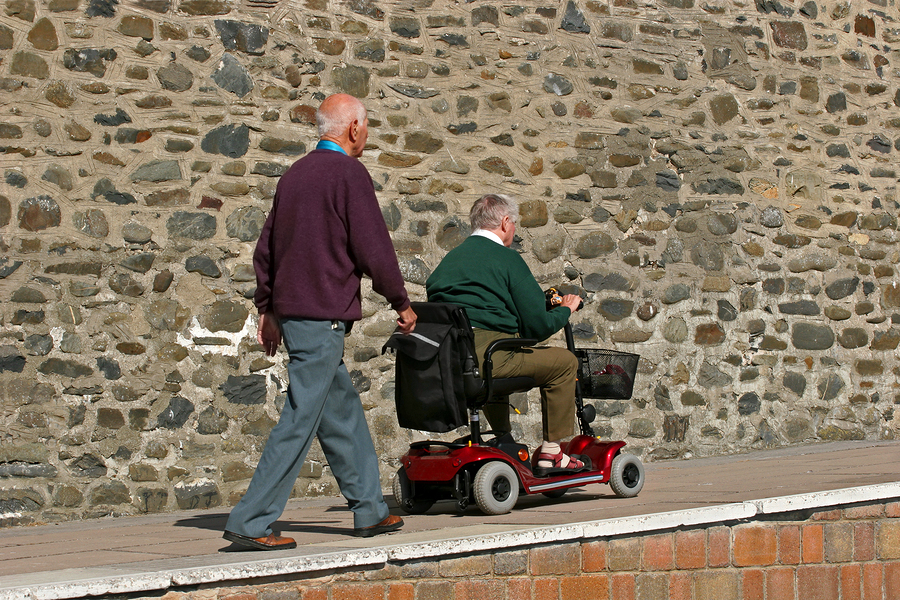Five Essential Maintenance Checks For Your Mobility Scooter
Like any method of transport in life, it’s a privilege to actually be able to get from A to B without fuss. From the car and the motorbike, to the moped and mobility scooter, each vehicle has made our lives easier as we can travel whenever we desire.
So in order for your mobility scooter to last that extra mile (no pun intended) it’s important to keep it well maintained and carry out checks on a regular basis.
With this in mind and to help you get started, take a look at these top maintenance tips from the team here at Blue Box Batteries.
1. Charging and checking the battery
As one of the most fundamental parts of your vehicle, the battery will supply your mobility scooter with the power you need to get to your destination.
Over time, the ability of the battery to hold charge will decrease and you’ll start to notice that more frequent charges will be required.
Always make sure that you have enough charge for the length of the journey you are about to undertake. Remember too that travelling uphill and using your lights will consume more battery power than usual. Charging times will also vary depending on make and model, so it’s best to consult the owner’s manual to see how long a full charge is supposed to take.
Check the battery for any wear and tear and if you notice any damage, or a significant reduction in its ability after a full charge, it may be time to get yourself a new battery.
For more information on replacing and installing mobility scooter batteries, check out our handy slideshare guide below.
2. Brake!
To avoid accidents and injury, it’s equally as important to check that your brakes are operating properly before you set off.
When testing the brakes, sit on your scooter and drive a few meters on a flat surface before applying the brakes lightly. Avoid doing this on a slope – in the rare event that the brakes aren’t working at all, you’ll start to gather speed without the ability to stop.
If you notice that the braking system seems weak or it isn’t as smooth as it’s been in the past, speak to a professional technician.
It’s also advised to get your brakes serviced once a year to make sure they’re working properly and to keep both you and pedestrians safe.
3. Tyre pressure and quality
With all that travelling and momentum, it’s no wonder that mobility scooter tyres are subject to general wear and tear.
Similar to a car, if your mobility scooter tyres have become worn down, it will be much more difficult to slow down and come to a stop. Check the owner’s manual to determine the right tyre pressure and look at the tyres to see if any of them are too flat and need to be pumped up.
Another factor to consider is the tyre tread – the grooves in the tyre that grip the scooter to the road. If these have become too worn then they will need replacing. Worn down wheels will require extra time to come to a stop when braking, especially in wetter conditions.
Therefore, get in the habit of checking your tyres twice a year and if you don’t know what you’re looking for, get them checked by an expert to make sure nothing’s been missed.

4. The seat
It’s likely that your mobility scooter features a detachable seat, so check that it’s securely in place before you hit the road.
This is easy enough to do and will require minimal time. Before you head off, simply give the seat a firm wiggle to see if it moves.
If it does then it will need to be tightened so that you can travel safely in comfort without worrying about the possibility of falling off and causing yourself injury.
5. A quick test drive
If you’ve not been out on your mobility scooter for a while, before you go out on it again, spend a few minutes test driving it to check that all is in working order.
Check the steering capabilities, lights, horn, brakes and acceleration. If you notice that any areas are underperforming then this could put a halt to your journey.
For example, if your lights don’t work, travelling in the dark isn’t going to be the most sensible option.
It’s better to find this out beforehand by giving your mobility scooter a quick test drive compared to leaving it too late - so make these quick checks first.
More mobility scooter advice
Thanks for reading the Blue Box Batteries guide to mobility scooter maintenance. Remember, it’s easy to carry out the above checks and in doing so you will be protecting your own safety and the safety of other pedestrians. Furthermore, you will also determine that your mobility scooter is classed as roadworthy.
For more information on mobility scooters, check out the Blue Box Batteries blog as well as our Facebook and Twitter profiles.
Mobility scooter image from Bigstock.
Latest Headlines
Bulk Orders
Discounted prices are available for bulk orders, please contact us to discuss your requirement.